Optimizing Single-Shot Coherent Power-Spectrum Scattering Imaging Adaptively by Tuning Feedback Coefficient for Practical Exposure Conditions
Abstract
1. Introduction
2. Inconsiderateness in Previous Single-Shot Coherent Power-Spectrum Imaging Methods
3. Exposure Level Estimation and Adaptive Selection of Suitable β Value
3.1. Exposure Level Estimation
3.2. Adaptive Selection of Suitable β Value
4. Experiment Results and Discussion
5. Conclusions
Author Contributions
Funding
Acknowledgments
Conflicts of Interest
References
- Freudiger, C.W.; Min, W.; Saar, B.G.; Lu, S.; Holtom, G.R.; He, C.; Tsai, J.C.; Kang, J.X.; Xie, S. Label-free biomedical imaging with high sensitivity by stimulated raman scattering microscopy. Science 2008, 322, 1857. [Google Scholar] [CrossRef] [PubMed]
- Krafft, C.; Schie, I.W.; Meyer, T.; Schmitt, M.; Popp, J. Developments in spontaneous and coherent Raman scattering microscopic imaging for biomedical applications. Chem. Soc. Rev. 2016, 45, 1819–1849. [Google Scholar] [CrossRef] [PubMed]
- Patel, C.; Steuwe, S.; Reichelt, S.; Mahajan. Coherent anti-stokes raman scattering for label-free biomedical imaging. J. Opt. 2013, 15, 2897–2903. [Google Scholar] [CrossRef][Green Version]
- Reginald, E.; Sunil, K. Laser transport through thin scattering layers. Appl. Opt. 2010, 49, 358. [Google Scholar]
- Wu, P.; Liang, Z.; Zhao, X.; Su, L.; Song, L. Lensless wide-field single-shot imaging through turbid media based on object-modulated speckles. Appl. Opt. 2017, 56, 3335. [Google Scholar] [CrossRef]
- Nagar, H.; Dekel, E.; Kasimov, D.; Roichman, Y. Non-diffracting beams for label-free imaging through turbid media. Opt. Lett. 2018, 43, 190. [Google Scholar] [CrossRef]
- Katz, E.S.; Silberberg, Y. Looking around corners and through thin turbid layers in real time with scattered incoherent light. Nat. Photon. 2012, 6, 549–553. [Google Scholar] [CrossRef]
- Bertolotti, J.; Van Putten, E.G.; Blum, C.; Lagendijk, A.; Vos, W.L.; Mosk, A.P. Non-invasive imaging through opaque scattering layers. Nature 2015, 491, 232–234. [Google Scholar] [CrossRef] [PubMed]
- Hsieh, C.L.; Ye, P.; Grange, R.; Laporte, G.; Psaltis, D. Imaging through turbid layers by scanning the phase conjugated second harmonic radiation from a nanoparticle. Opt. Exp. 2010, 18, 20723–20731. [Google Scholar] [CrossRef] [PubMed]
- Singh, K.; Naik, D.N.; Pedrini, G.; Takeda, M.; Osten, W. Looking through a diffuser and around an opaque surface: A holographic approach. Opt. Exp. 2014, 22, 7694–7701. [Google Scholar] [CrossRef] [PubMed]
- Tang, W.; Yang, J.; Yi, W.; Nie, Q.; Zhu, J.; Zhu, M.; Guo, Y.; Li, M.; Li, X.; Wang, W. Single-shot coherent power-spectrum imaging of objects hidden by opaque scattering media. Appl. Opt. 2019, 58, 1033–1039. [Google Scholar] [CrossRef]
- Fienup, J.R.; Wackerman, C.C. Phase-retrieval stagnation problems and solutions. J. Opt. Soc. Am. A 2008, 3, 1897. [Google Scholar] [CrossRef]
- Minkevich, M.; Köhl, T.B. Improved success rate and stability for phase retrieval by including randomized overrelaxation in the hybrid input output algorithm. Opt. Exp. 2012, 20, 17093–17106. [Google Scholar]
- Shi, L.; Wetzstein, G.; Lane, T.J. A flexible phase retrieval framework for flux-limited coherent X-ray imaging. arXiv 2016, arXiv:1606.01195. [Google Scholar]
- Rd, T.R.; Hyland, D. Mitigating the effect of noise in the hybrid input-output method of phase retrieval. Appl. Opt. 2013, 52, 3031–3037. [Google Scholar]
- Fienup, J.R.; Feldkamp, G.B. Astronomical imaging by processing stellar speckle interferometry data. Proc. SPIE Int. Soc. Opt. Eng. 1980, 243, 95–102. [Google Scholar]
- Zhang, H.; Cao, J.; Tang, L.; Wang, H. A new algorithm for auto-exposure based on the analogy histogram. In Proceedings of the 2011 Seventh International Conference on Computational Intelligence and Security, Hainan, China, 3–4 December 2011. [Google Scholar]
- Fienup, J.R. Reconstruction of an object from the modulus of its Fourier transform. Opt. Lett. 1978, 3, 27–29. [Google Scholar] [CrossRef] [PubMed]
- Tang, W.; Guo, Y.; Yi, W.; Yang, J.; Zhu, J.; Wang, W.; Li, X. A robust fast variable-aperture Fourier ptychography. Opt. Commun. 2019, 443, 144–149. [Google Scholar] [CrossRef]


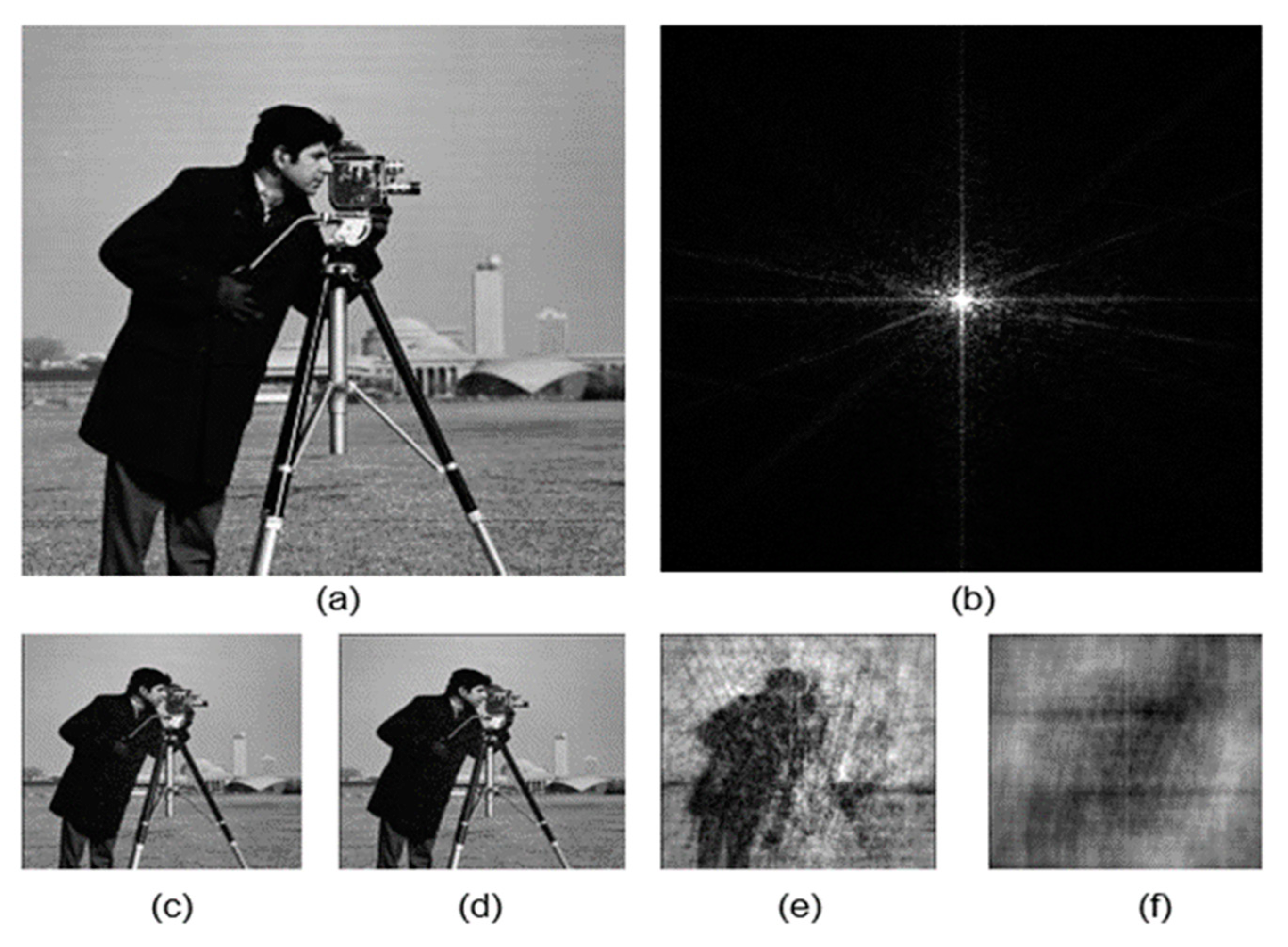
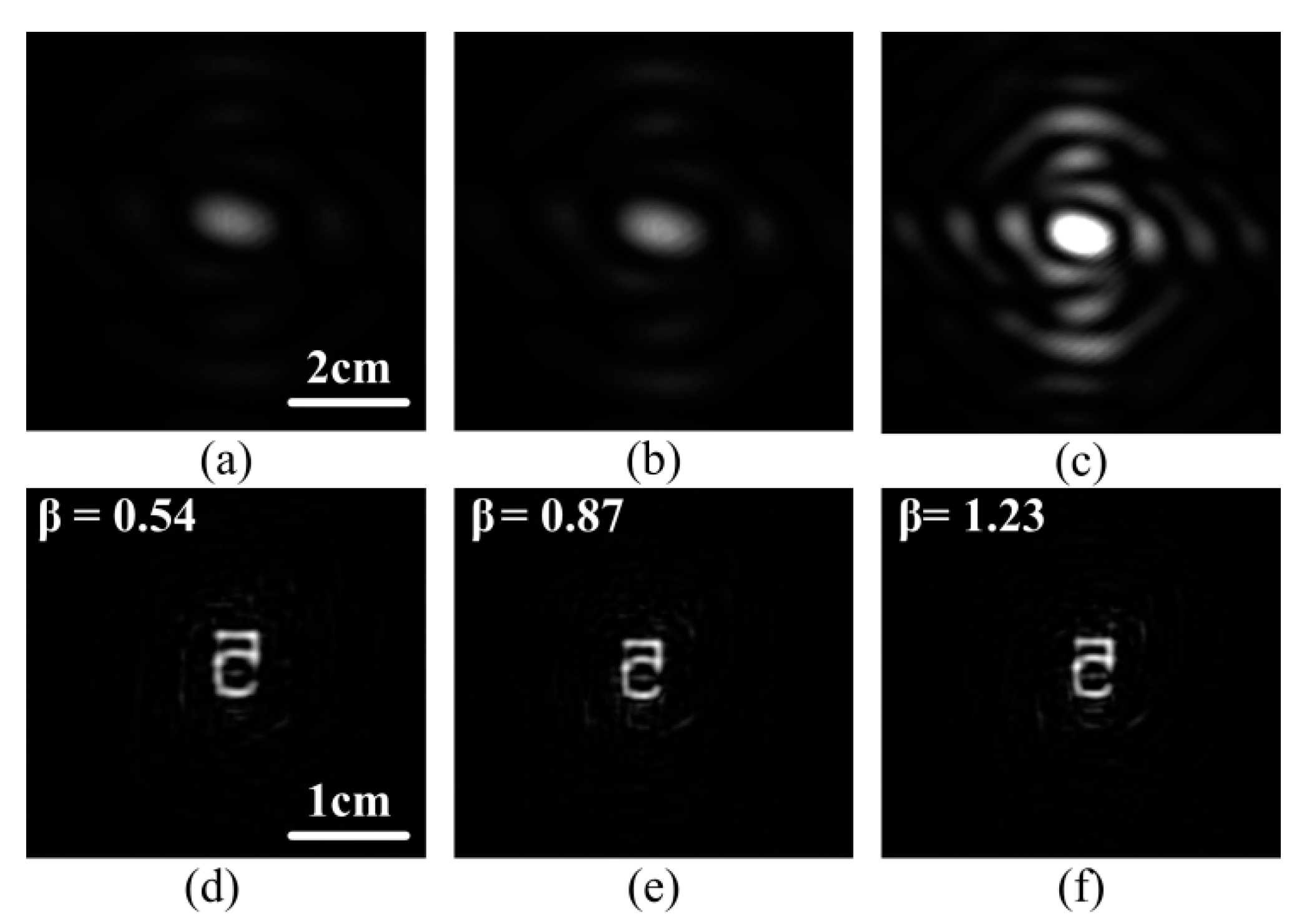
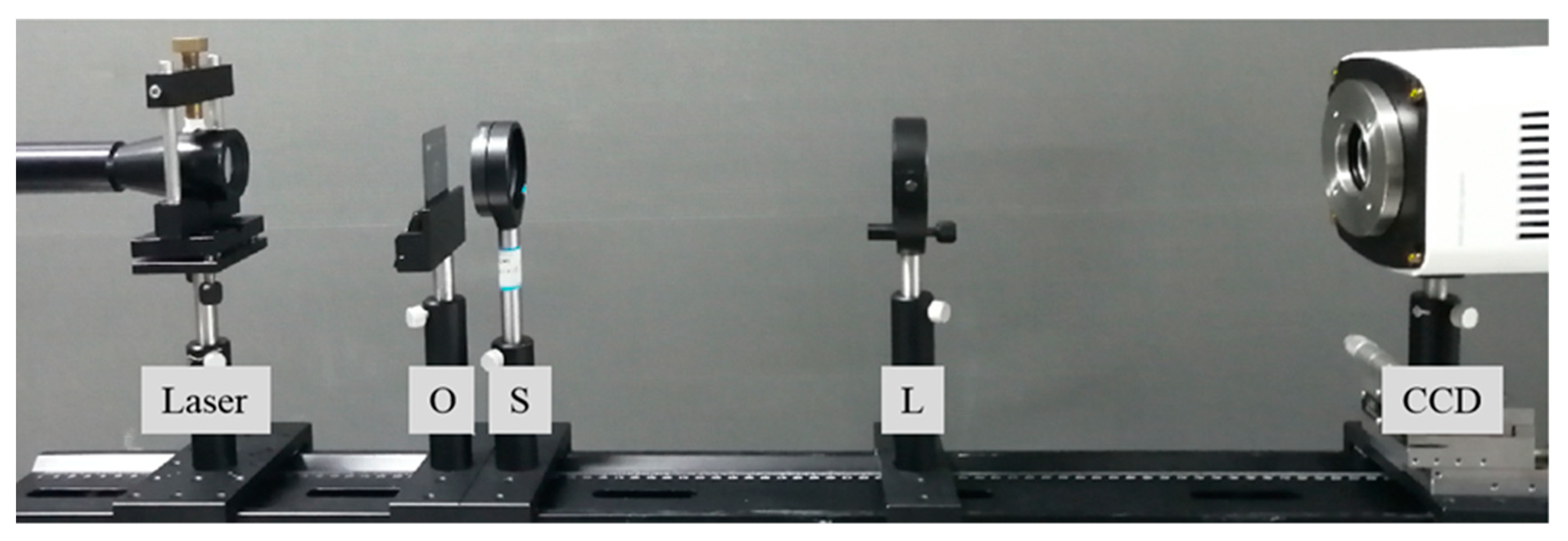

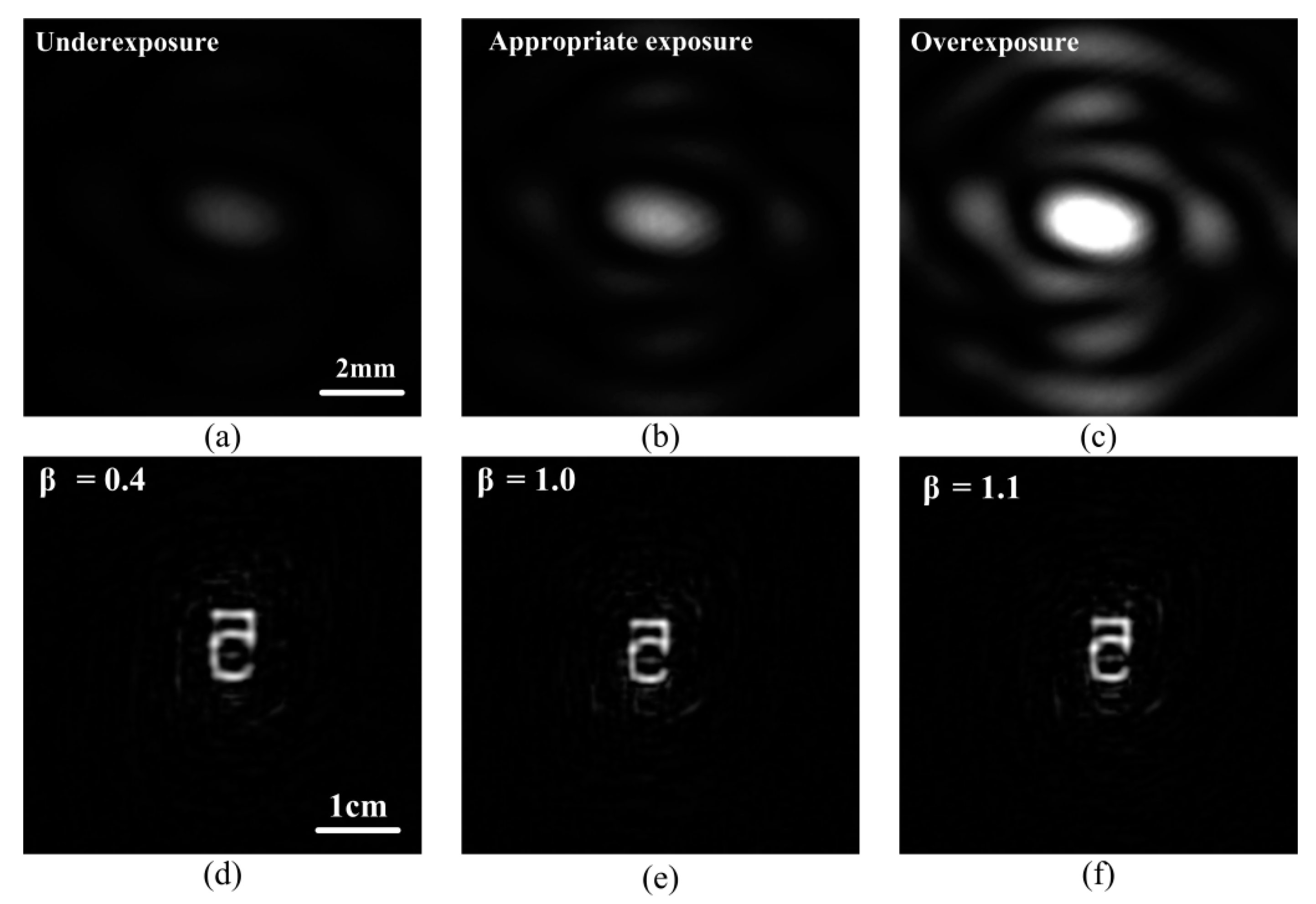
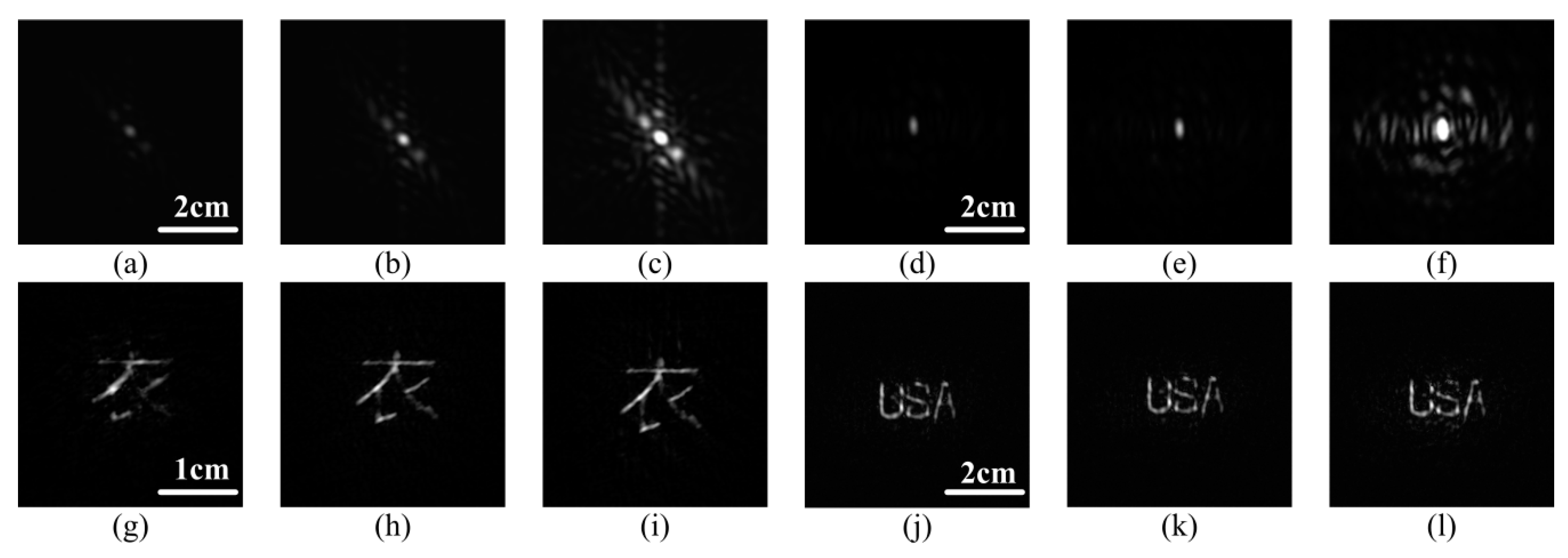
| Captured Power-Spectrum Pattern | (a1) | (b1) | (c1) | (d1) | (e1) | (f1) |
|---|---|---|---|---|---|---|
| β = 0.1 | N | N | N | N | N | N |
| β = 0.2 | Y | N | N | N | N | N |
| β = 0.3 | Y | Y | N | N | N | N |
| β = 0.4 | Y | Y | N | N | N | N |
| β = 0.5 | N | Y | N | N | N | N |
| β = 0.6 | Y | Y | N | N | N | N |
| β = 0.7 | Y | Y | Y | Y | N | N |
| β = 0.8 | Y | Y | Y | Y | N | N |
| β = 0.9 | N | Y | Y | Y | N | N |
| β = 1.0 | N | N | Y | Y | Y | Y |
| β = 1.1 | N | N | N | N | Y | Y |
| β = 1.2 | N | N | N | N | Y | Y |
| β = 1.3 | N | N | N | N | Y | Y |
| β = 1.4 | N | N | N | N | Y | N |
| β = 1.5 | N | N | N | N | N | N |
© 2019 by the authors. Licensee MDPI, Basel, Switzerland. This article is an open access article distributed under the terms and conditions of the Creative Commons Attribution (CC BY) license (http://creativecommons.org/licenses/by/4.0/).
Share and Cite
Wang, W.; Guo, Y.; Tang, W.; Yi, W.; Li, M.; Zhu, M.; Qi, J.; Zhu, J.; Li, X. Optimizing Single-Shot Coherent Power-Spectrum Scattering Imaging Adaptively by Tuning Feedback Coefficient for Practical Exposure Conditions. Appl. Sci. 2019, 9, 3676. https://doi.org/10.3390/app9183676
Wang W, Guo Y, Tang W, Yi W, Li M, Zhu M, Qi J, Zhu J, Li X. Optimizing Single-Shot Coherent Power-Spectrum Scattering Imaging Adaptively by Tuning Feedback Coefficient for Practical Exposure Conditions. Applied Sciences. 2019; 9(18):3676. https://doi.org/10.3390/app9183676
Chicago/Turabian StyleWang, Wei, Yanfang Guo, Wusheng Tang, Wenjun Yi, Mengzhu Li, Mengjun Zhu, Junli Qi, Jubo Zhu, and Xiujian Li. 2019. "Optimizing Single-Shot Coherent Power-Spectrum Scattering Imaging Adaptively by Tuning Feedback Coefficient for Practical Exposure Conditions" Applied Sciences 9, no. 18: 3676. https://doi.org/10.3390/app9183676
APA StyleWang, W., Guo, Y., Tang, W., Yi, W., Li, M., Zhu, M., Qi, J., Zhu, J., & Li, X. (2019). Optimizing Single-Shot Coherent Power-Spectrum Scattering Imaging Adaptively by Tuning Feedback Coefficient for Practical Exposure Conditions. Applied Sciences, 9(18), 3676. https://doi.org/10.3390/app9183676






